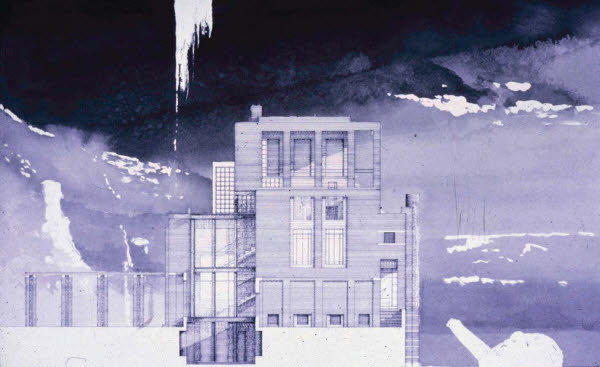Sections can be extraordinary drawings. Like plans, they can be the abstract bearers of information, showing heights of rooms, floor thicknesses, and constructional details. But a section through a building also embodies a rather special set of conditions: a section presents the “verticality” of a building: it shows how the building sits with respect to the earth and how it meets the sky. More than any other drawing type, a section declares how the building admits natural light, and describes the thicknesses or transparencies of external walls. Interiors are described in terms of their material surfaces, their depths, passages, and transitional spaces. Above all, a section is a “grounded” drawing: on an uncluttered page a section can be among the most powerful of drawings to describe the organization of space.
Like a plan, a section is an orthographic projection, but from the position of a vertical plane. Sections can be cut anywhere through a building, but tend to be taken where there is a significant spatial condition to describe. Internal elevations will appear between floor plates, and an external elevation appears in a section where the vertical plane is taken from outside, or partially outside, of the building.
A section generally offers itself to more elaborate rendering than a plan, partly because of the elevations that are described, but also because a section is a key drawing to describe the way in which light works in a building. In rendering light conditions and material textures internally or externally, the section can convey a concrete sense of the proposal.


Alsop Architects’ striking elevational renders are full of color. Sciagraphy helps describe the depth of façade, and the graphic pattern is emphasized by the simple rendering of ground plane and background.
How contextual a section is depends on the scale of the drawing. At a large scale a section can describe a building’s relationship to a whole landscape or a city. A landscape section highlights changes in ground level but is otherwise not the best drawing to describe garden or landscape context, as in a section it will only appear in elevation. On the other hand, an urban section can be an important key drawing, since it will show the scale and proportion of internal and external spaces, and how public and private space is mediated by a vertical layering of the building.
Detail sections are fundamental to conveying construction and technical performance; these kinds of drawings are about clarity of information and are drawn with precisely calibrated line widths.
TIP PLACING A SECTION
A section is best located at the bottom of a sheet. Don’t draw anything above it; it should represent a transition between ground and sky.
TIP SECTIONAL CUT
Key to a section is the definition of sectional cut. Take the section through significant spaces, not through structure or secondary circulation spaces.

Eric Parry’s sectional elevation is done in pencil, pen, and ink wash. The ink has been skillfully employed to depict landscape, light, and shade. Sciagraphy helps define façade depth and form.
